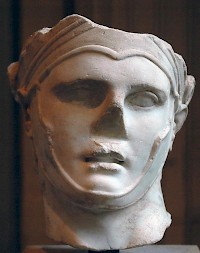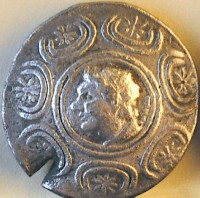Ptolemy Keraunos
Ptolemy Keraunos ("thunderbolt"; †279): son of the Egyptian king Ptolemy I Soter, adventurer, briefly king of Macedonia (r.281-279).

Ptolemaic Court Intrigues
In the family of king Ptolemy of Egypt, names could be confusing. He was married at least four times, and had several sons. His third wife Eurydice, a daughter of a Macedonian nobleman named Antipater, had given birth to a boy named Ptolemy, who was his intended successor; and his fourth wife, Berenice I, was mother of another son, also called Ptolemy. The first boy was later called Keraunos, "thunderbolt"; the second son was later called Philadelphus, "the man who loves his sister".
It was always clear that Keraunos was to succeed king Ptolemy, but towards the end of his reign, he started to prefer Philadelphus. The reason that is usually given is a court intrigue in which Eurydice and Berenice played a role, and this may or may not be true. Anyhow, Philadelphus became heir apparent and is mentioned in several papyri from the years 285-283 as king Ptolemy's co-ruler. He was crowned as pharaoh on 7 January 282.
Exile
Meanwhile, Keraunos had left Egypt and arrived at the court of Lysimachus, the king of Thrace, Macedonia and western Asia Minor. Like king Ptolemy, he had once been an officer in the army of Alexander the Great. Lysimachus was married to Arsinoe II, a half-sister of Keraunos, who offered Keraunos a warm welcome. However, there were family troubles in the house of Lysimachus as well. From an earlier marriage, Lysimachus had a son named Agathocles, who was married to Lysandra, a full sister of Keraunos. It was clear that Agathocles was to succeed his father, and this meant that Arsinoe and her three children were to become the subjects of her half-sister. She started to blacken Agathocles, and eventually, Lysimachus ordered the execution of his own son. Lysandra decided to leave court and fled to Seleucus, the king of Asia, who resided in Babylon; Keraunos accompanied his sister. He was a refugee again.
Seleucus Intervenes

When Lysandra and Keraunos arrived in Babylonia, they asked Seleucus to come to their assistance. This was an offer he could not refuse: he could now rightfully intervene in the kingdom of Lysimachus (where he could place a son of Lysandra and Agathocles on the throne) and he could also intervene in Egypt (where he could place Ptolemy Keraunos on the throne). The thought that he could also place himself on both thrones must have crossed his mind. From a recently discovered Babylonian chronicle, the "End of Seleucus Chronicle", we know that in the summer of 282, Seleucus started to muster an army.
In the winter of 282/281, he invaded Lysimachus' Asian possessions. Seleucus was a prudent man: before he set out, he had already appointed his son Antiochus as his successor. Seleucus proceeded to the plain of Corupedium, not far from Sardes, where the army of the seventy-seven years old Seleucus met the army of Lysimachus, eighty years old. A battle was fought in February, and Lysimachus was killed in action.
Seleucus advanced to the northwest, where nothing could prevent him from adding Thrace and Macedonia to his empire. At this point, the End of Seleucus chronicle makes a tantalizing, unclear remark that certain military men "rebelled against him and ... killed him". Unfortunately, we cannot identify these military men, and are also uncertain about the identities of the killer and his victim. We only know that it made a lasting impression on the author of the chronicle.

In the late summer, Seleucus crossed the Hellespont and wanted to visit Thrace and Macedonia, where he wanted to be recognized as king. However, he never reached this aim, because he was stabbed to death by Keraunos, who received this surname, "thunderbolt", because of this act. According to the Babylonian King List of the Hellenistic Period, the assassination took place between 26 August and 24 September 281.
King Keraunos
We do not know Keraunos' motives, but it is likely that Seleucus had made it too clear that he wanted to reunite the empire of Alexander the Great and did not want to give parts to Keraunos or the son of Lysandra and Agathocles. Or perhaps he had started to distrust Keraunos, just like king Ptolemy had.
However this may be, once rid of Seleucus, it was easy for Keraunos to obtain Thrace and Macedonia. He had served as an officer in the armies of both Seleucus and Lysimachus, and the soldiers accepted him as their king. As a grandson of Antipater, who had long been viceroy of Macedonia, recognition in the old kingdom was also easy. Three other candidates could challenge his claim to the throne, but none of them was really dangerous: Seleucus' son Antiochus had to defend himself against an Egyptian attack and agreed to a peace treaty with Keraunos; king Pyrrhus of Epirus waived his claim to the Macedonian throne; and only Antigonus II Gonatas (whose father Demetrius Poliorcetes had once ruled Macedonia) put up fight. But he was defeated.
Keraunos' next step was to ask his half-sister Arsinoe, the widow of Lysimachus, to marry him. In this way, the new king would strengthen his position. Immediately after the ceremony, his real motives became clear, because he killed Arsinoe's children, who were, after all, potential rivals. The queen herself fled to Egypt, and married for the third time, with king Ptolemy Philadelphus, her brother. Not much later, Keraunos wrote to his half-brother, saying that he gave up his claims to the Egyptian throne and wanted to improve relations.
Demise

There was not enough time to enjoy the new harmony. In 279, a new enemy appeared in what is now northern Bulgaria: the Galatians. They belonged to the La Tène-culture, which had its heartland in eastern France and southern Germany. In the fifth and fourth centuries, it had expanded to the west into the countries where people spoke a language that modern scholars call "Celtic". Because the Greeks used the word "Celt" to describe all barbarians in the west (except for those on the British isles), twentieth-century scholars have used the word 'Celtic' to describe all La Tène-people, even when they did not live in the west and did not speak a Celtic language. Therefore, the Galatians are sometimes called Celts, which is factually doubtful but has the advantage that people immediately understand that the Galatians were savages.

King Ptolemy Keraunos was no match for them. When the Thracian tribes asked for his help, he refused, thinking that if they were weakened by the invaders, they were less dangerous to his own kingdom. This was a big mistake, because the Thracians were now forced to join the Galatians. In the spring of 279, their leader Bolgius invaded Macedonia, and when Keraunos offered battle, he was defeated, captured, and decapitated.
This was the end of a most unscrupulous adventurer, but it was not the end of the Galatian invasion. Keraunos' brother Meleager was made king, was replaced by a man named Antipater, who was in turn replaced by a Macedonian nobleman named Sosthenes. He was able to repel Bolgius, but another band of Galatians, commanded by Brennus ("duke") proceeded to Central Greece. The Galatian storm, however, was not to last forever: Antigonus Gonatas defeated the invaders and became king of Macedonia. His dynasty, the Antigonids, was to last for more than a century.